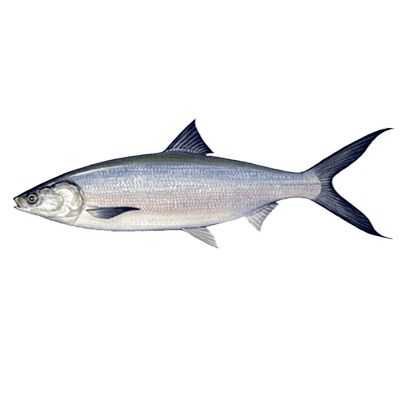Milkfish

Species Details
Chanos Chanos
Chanidae
Gonorynchiformes
Mangrove Swamps, Estuaries, Coral Reefs,
2 - 31 lbs.
39" - 71"
Milkfish (Chanos Chanos) Fish Description
Milkfishes appear silver in color. They have a fusiform body; long and elongated. Their backs are normally a dark blue color which slowly changes into silver-white once it gets past the lateral line. They have a deeply forked tail. They have no spines on their fins, only rays. In appearance, they are quite a sight to behold as they are streamlined in appearance.
They have straight pectoral fins with their anal fin being a little curved in appearance.
Diet and Size
Milkfish eat a variety of invertebrates. They also eat algae whenever they can. Most of the time, Milkfishes go around in schools near coral reefs. They don’t have teeth so they don’t normally feast on meaty or hard-shelled food like crustaceans.
Milkfishes are quite small commercially. But left alone, these fishes can grow up to 5’11 ft. Although, commonly they remain around 39 inches. They can weigh up to 31 lbs.
Interesting Facts about the Milkfish
- Milkfish is a very common fish in Southeast Asia.
- They go by different names:
- Ibiya – Nauruan
- Awa – Hawaiian
- Bangus – Filipino
- Ava – Tahitian
- Bandeng/Bolu – Bahasa
- They go by different names:
- Milkfish is very popular.
- They are known for their white meat and their versatility as food.
- Many people usually eat their Milkfish fried. Some however have baked it and even put it in a soup. At times, Asian cuisines boil the Milkfish with sour fruits such as Tamarind or Tree Sorrel. Though, Tree Sorrel may commonly be known as Bilimbi. Or if you’re in the Philippines, Kamias.
- Some even smoke it and ferment it in salt which preserves its shelf life.
- Milkfishes are considered the national fish of the Philippines.
- Milkfish is not advisable to eat for children at a young age.
- Milkfish are known to have a lot of bones. Unlike fish that have hard bones, Milkfish has soft, thread-like bones that look like feathers.
- Unless you’re quite keen on flaking fish, best to buy the boneless Milkfish.
- It was because children tended to choke on their bones that people opted to sell Boneless Milkfish.
- Because of their popularity, Milkfish are commonly subjected to aquaculture.
Milkfish – Fishing Techniques: How to Fish for a Milkfish
When fishing for a Milkfish, people usually do Flyfishing. Milkfishes often loiter and swim around in rivers, making them highly susceptible to flyfishing. Since they’re not predatory also, using fish as bait doesn’t attract them either. Insects or fish roe are recommended baits for catching Milkfish.
One thing people mentioned also about catching a Milkfish is that it puts up a good fight. Unlike regular animals, they don’t have lactic acid build-ups. Usually, the body gets tired and people feel pain after doing a lot of work. That’s caused by lactic acid. Imagine now that these fish are incapable of that and coupled with their fierce nature, you’re in for a fight.
When casting your line, make sure you can actually see where the Milkfish are feeding. Since they’re not predatory, they’ll be more inclined to ignore the line you just threw in. Don’t be afraid to keep casting until you get it right.
Habitat and Distribution
Milkfish love staying in rivers which is why the best way to catch them is through Flyfishing. Since they also don’t feed on fish, they usually stay in places that have a lot of algae. Milkfish also stay near coasts of islands that have a lot of coral reefs. However, they only return to the sea if they’re planning to lay eggs.
Milkfish are also known to stay in Mangrove Swamps which have an abundance of algae. One way you can try also getting them is smearing your line with algae. Some farmers have used nets and purposely let algae grow on them so it would lure the Milkfish to the net only to catch them in the net.







